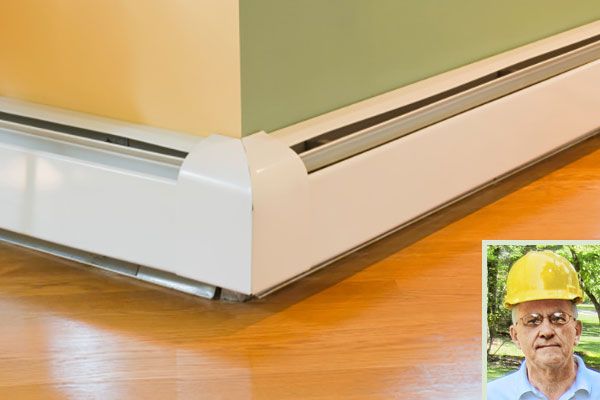Introducing: the Plough Plane

Routers scare me. Is there another way for me to make grooves in boards?
—Jeremy Powers Portland, Oreg.
Bob Flynn replies: Long before there were motorized routers, craftsmen who needed to cut grooves reached for a plough plane, like my maple-bodied beauty here. Its two large wooden screws adjust a fence, which controls where the blade makes its cut. This tool was made in the early 1800s by Casey & Co. of Auburn, New York. Grasping its finely sculpted handle feels like shaking the hand of an old friend.
Hydrangeas

We have a hydrangea that we moved from the ground to a container. Can we leave it outside all winter, or would it do better inside a garage?
—Don Stewart, Wadsworth, Ohio
Susan Cohan replies: In the ground, many types of hydrangeas can survive your USDA Zone 6 winters. But in a pot exposed on all sides, the roots will suffer more frequent freeze-thaw cycles and need to be given extra protection.
The safest approach is to move the container into an unheated garage and water the soil periodically during the winter. Put it back outside in early spring when the danger of a deep freeze is past.
But if you’d rather leave the pot outside, place it in a spot sheltered from the wind and out of the sun. There’s no need to cover the plant, but you can insulate the soil from temperature swings by piling leaf mulch around the outside of the container and holding the mulch in place with burlap. Snow also provides good insulation if the pot is buried in it.
Whether the container spends the winter in a garage or outside, make sure it can survive freezing temperatures. Fiberglass, concrete, stone, metal, and wood are generally frost-proof; ceramic, including terra-cotta, is not.
Also, raise the pot off the ground to prevent ice from plugging the drain hole and turning the soil into a frozen-solid block. If your hydrangea is a reblooming big-leaf variety, like H. macrophylla ‘Endless Summer,’ cut the stems back to about 6 to 8 inches from the top of the pot in late fall. That will encourage the growth of new stems and more blooms next spring.
Shown: A hydrangea can survive the winter if you take steps to insulate the soil from the freeze-thaw cycles that destroy pots and kill the roots.
When the Tub Has to Go

What’s the easiest way to remove the tub in our master bathroom? We want to replace
it with a tiled shower stall.
—Julie Kissell, Sandwich, Mass.
Michael Bond replies: It depends on what your tub is made of. If it’s fiberglass or acrylic, cut away about 2 to 3 inches of the wall around the perimeter of the tub’s surround, then pull the nails that secure the surround to the studs. Take off the shower valve’s trim and handle, and use a reciprocating saw with a metal-cutting blade to cut the tub into pieces that can be easily removed. When the drain is exposed, unscrew it or cut through it with the same blade.
For a cast-iron tub, break out the wall tile next to the tub with a hammer and disconnect the drain and the overflow. Now take a large sledgehammer and whack the tub across the middle to break it into manageable sections, which are easier to carry out than an intact 300- to 400-pound piece. Before you start swinging, however, protect yourself from flying, razor-sharp cast-iron shards by donning safety glasses, long pants, a long-sleeve shirt, work gloves, and—very important—ear plugs.
Once the tub is gone, but before you start rebuilding, take down any drywall next to the tub and check for mold and damage to the framing.
Bad Smell from the Main Drain

After the laundry tub in the basement overflowed a few years ago, a camera inspection revealed a sagging main sewage pipe under the basement slab. Now we smell sewage. I fear the sag has caused a break in the main drain. What now?
—William Dols, Rockville, MD.
Gerry Pomanti replies: If there were a break in the line, it would have developed a blockage pretty quickly. Since a blockage has not reoccurred, the most likely suspect for a sewage smell would be a dry P-trap in a floor drain.
A P-trap is meant to hold a slug of water that blocks the noxious gases in a sewer system or septic tank from getting into the house. In frequently used traps, like the ones connected to sinks, the water is constantly replenished. But floor drains rarely have water draining into them, so the slug evaporates and lets in the smelly gases. Try pouring some water into the drain to replenish the trap seal. The smell should go away.
Adding water periodically is the simplest way to keep a trap in working order. I know that some people drizzle mineral oil into the drain to slow down evaporation, but I think a trap-seal plug like SureSeal would be a better solution. It lets water through but keeps the gases from escaping. You fit it into the drain outlet and forget it.
Stop Roof Sag

Our roofline is sagging, along with one side of the roof. Who should I call to take a look at it and fix it?
—Thomas Reddinger, York Springs, Pa.
Michael Bond replies: A sagging ridge can be a serious structural issue, so you should call a contractor and have him bring a structural engineer. They should both be on-site at the same time to determine what’s going on.
You may find that your roof needs only minor fixes with additional structural support. Or it may require major work, such as replacing structural members and jacking up the roof.
This is not something to put off—have it looked at now, before it gets worse.
Convert a 220-Volt Circuit to 110

Can I use the 220-volt wiring from an abandoned electric baseboard heater in a 110-volt outlet?
—Darrel Robinson, Lyden, Wash.
Maurice Turgeon replies: Yes, you can easily convert a 220- or 240-volt circuit to 110 or 120 volts—as long as the baseboard heater is the only load on the circuit.
Start the conversion by hiring a licensed electrician to replace the two-pole circuit breaker in the main electrical panel with a single-pole 20-amp breaker that also functions as an arc-fault circuit interrupter (AFCI). This type of combination breaker offers the best protection against fires caused by arcing wires, and it is required by the National Electrical Code (NEC).
You can take care of installing the receptacle at the other end of the circuit. It should be rated for 120 volts and 20 amps, to match the new breaker, and be tamper resistant (TR). The NEC also mandates TR receptacles.
The cable that went to the baseboard heater probably has thick, very stiff 10-gauge wires. To make the job of attaching them to the receptacle easier, install a two-gang box, which has more room to work in than a single-gang box. Feed the cable into the box, and use wire nuts to connect the thick wires to short lengths of flexible, stranded 12-gauge copper jumper wires. Keep the wire colors consistent: Use a black jumper on the cable’s black wire, a white jumper on the white wire, and a green jumper on the ground wire.
Here’s another advantage to using a two-gang box: You can install a second receptacle in it. Just twist an extra jumper onto each 10-gauge wire, as above, and connect each jumper to the appropriate receptacle terminal.
Fix for a Crooked Steel Door

How do I fix a steel entry door that no longer hangs square in its opening? I’d rather not replace it.
—Glen Stimson, Marlborough, Mass.
Michael Bond replies: Have you checked the hinge screws? Maybe they’re loose and need to be retightened. If they’re stripped and can’t be tightened, back them out, glue a matchstick-size sliver of wood in each hole, and drive the screws back into place.
If the door still sags, and it’s mounted on wood jambs, then the door’s weight has probably pulled the hinge-side jamb out of plumb. The solution is simple: Install longer screws that go through the jamb and bite into the hinge-side studs.
To do that, open the door wide enough for you to back out a screw from the top hinge—the screw closest to the centerline of the jamb. Then take a 4-inch flathead screw with a head the same diameter as the hinge-leaf holes and drive it through the jamb and into the stud. Tighten or loosen this screw until the gap across the top of the
door is even. It won’t hurt to do the same thing to the other hinges.
But if the door jambs are steel, they’ll need to be resquared. To do that, back out the two screws at the bottom of the hinge-side jamb—one on the inside face, one on the outside—and use a pry bar to push the jamb up until the gap across the top of the door is even. Put a hardwood shim under that jamb and anchor it in place with two new screws, 1 inch longer than the originals, driven through the jamb’s existing screw holes and into the framing.
Driveway Edge Treatment

I am getting ready to put in a gravel driveway. What should I use along the edge to keep the gravel in and the grass out?
—Greg Landrum, Russiaville, Ind.
Susan Cohan replies: My favorite way to contain gravel is with two rows of pavers, one set upright on edge or on end and the other lying flat like a ribbon between the gravel and the upright row. The upright row should be anchored in mortar so that the pavers won’t move. The ribbon pieces can be set in sand or stone dust, their faces even with the top of the gravel.
Belgian blocks are a fantastic material for this application. They’re granite, and therefore incredibly durable, and they look great next to gravel. Brick or concrete pavers are less expensive options that perform nearly as well.
Swing for a Porch

I don’t know where to hang the porch swing our kids bought us, because vinyl panels cover the porch ceiling. A stud finder proved useless. How do I find something sturdy enough to hang the swing on without removing the panels?
—Keith Svendsen, Xenia, Ohio
Michael Bond replies: Unfortunately, you can’t. At least one panel will have to come off temporarily so that you can locate the ceiling joists and see whether they’ll support the swing.
To remove a panel, you’ll need a pry bar and a vinyl-siding-removal tool, like the SideSwiper II. Use the removal tool to separate the panel’s interlocking edges and the pry bar to pull out the nails that support the panel.
Once you free a panel near where you want to hang the swing and peer into the space beneath the porch-roof rafters, you’ll probably find a grid of 1x3s nailed to the underside of ceiling joists. If those joists are 2x6s or bigger, you’re in luck: Drill ⅜-inch pilot holes though the vinyl and into the bottom edge of a joist or pair of joists, depending on how the swing is oriented. To beef up 2×4 joists, glue and screw a 2×6 of the same length to the 2×4’s face, and anchor both of them to the house with a double joist hanger. Drill the pilot holes into the 2×6’s edge.
Twist a 6-inch-long, ½-inch-diameter galvanized eye screw into each pilot hole until the eye is just below the ceiling. Nail the panel back into place—make sure it can slide freely from end to end—and use the removal tool to hook it back onto the other panels. Hang your swing securely from the screws and enjoy!
Shown: A friendly porch swing requires sturdy support: a 2×6 or larger ceiling joist and a hefty pair of ½-inch-diameter galvanized eye screws. Learn how to hang a swing.
